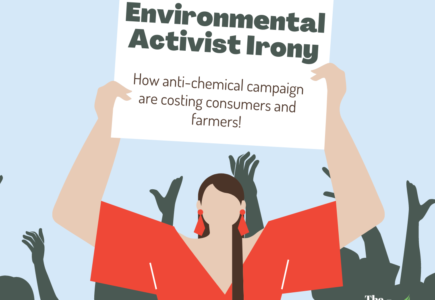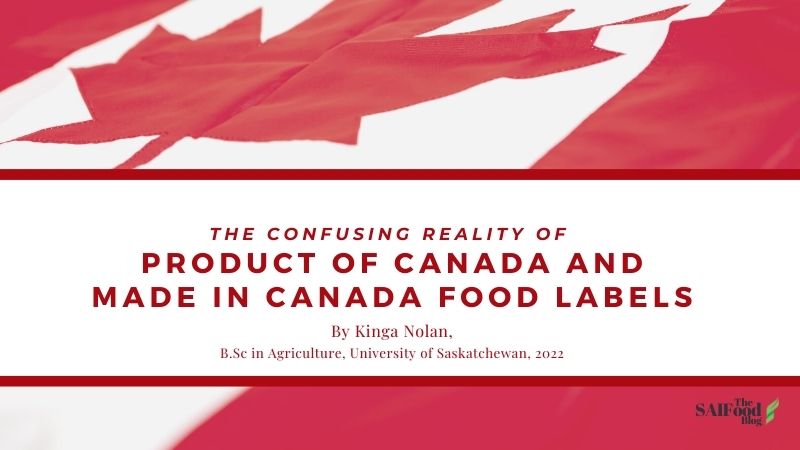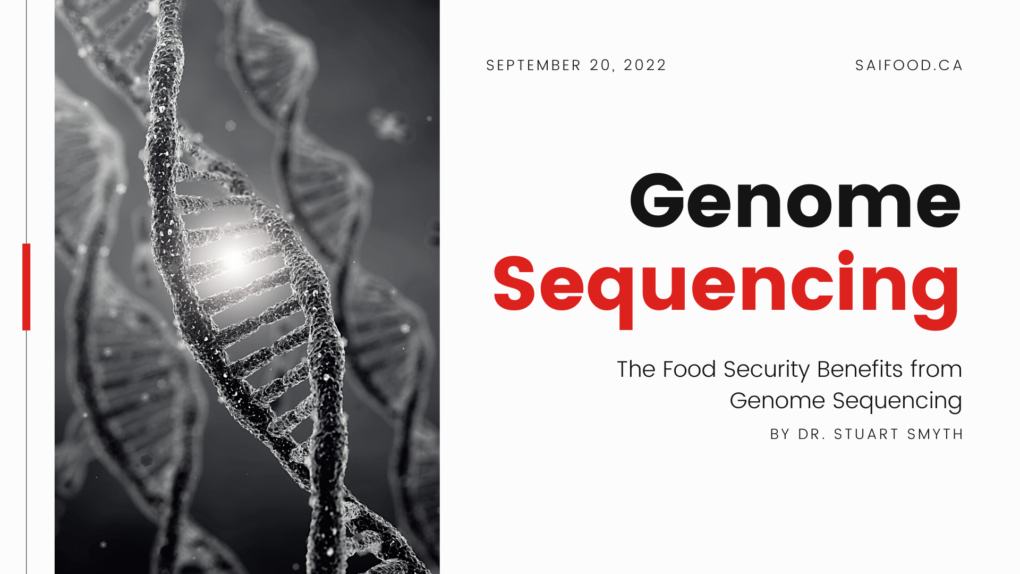The following article was originally posted by the Genetic Literacy Project (GLP), on August 25, 2022. Click here to see Dr. Smyth’s original post. Thank you to GLP for allowing us to share this post with our audience!
Environmental activist irony: Anti-chemical campaigners end up promoting higher food prices with few farming or health benefits
While food prices are rising, and with everyone from consumers to politicians in alarm mode, one segment of the public is actively (if inadvertently) campaigning for even higher prices: environmental non-governmental organizations (ENGOs) advocacy groups backed by the organic industry. Here’s what the ENGOs are proposing or have enacted in just the past two years:
- In Europe, which is on the verge of passing a so-called Green Deal Farm to Fork policy, organic lobbyists have succeeded in convincing the EU to enact policies that will require a 50% reduction in the use of agricultural chemicals by 2030.
- In Germany, in 2021, the government confirmed that it will ban glyphosate by 2023, and is targeting to produce 30% of its food from organic production by 2030. (https://www.gmo-free-regions.org/de/gmo-news/meldung/34514.html) This is in spite of the evidence that organic crops yield an average of 30% less than conventional production methods that rely on synthetic chemicals and up to 70% less for some vegetable crops.
- In Mexico, in January 2021, the government announced it would ban the import of GM corn and phase out the use of the weedkiller glyphosate by the end of 2023. Greenpeace fully supports this decree, stating that production would be “maintained”.
- The USDA announced this past June that it will provide $300 million in subsidies for organic agriculture, claiming this would increase production and benefit consumers.
ENGOs are the major force behind these legislative actions. One of the most aggressive, Pesticide Action Network, relentlessly calls for phase-outs and bans on chemicals in the production of food, regardless of whether countries are industrial, developed countries, transitioning economies, or low to middle-income countries.
They cite “an alarming number of hazardous pesticides still in use, writing:
Highly Hazardous Pesticides contribute to the unacceptable situation that an estimated 385 million children, women and men suffer from unintended acute pesticide poisoning each year …. Brain damage, IQ-loss, cancer, autism – children are especially at risk ….
These increasingly powerful ENGOs proudly define themselves as chemical rejectionists, but that’s both self-serving and wrong; they target chemicals judged safe by independent global regulatory bodies, such as glyphosate, but have no interest in restricting some of the most dangerous chemicals—if they are used by their ideological partners in the organic industry.
As it turns out, and surprisingly to many, the US and Canada—oft targeted by PAN and other activists for their embrace of conventional farming techniques, which often includes the judicious use of synthetic chemicals—use about half as much highly toxic chemicals per acre as precautionary-obsessed countries like Belgium and France.
Why? Because European farming is awash in virtually unregulated ‘natural’ chemicals, particularly copper sulfate, widely used in wine-growing areas among other farming regions to control fungus.
According to the National Pesticide Information Center at Oregon State University, “Copper sulfate can cause severe eye irritation. Eating large amounts of copper sulfate can lead to nausea, vomiting, and damage to body tissues, blood cells, the liver, and kidneys. With extreme exposures, shock and death can occur. Copper sulfate affects animals in a similar way.”
The European Food Safety Authority has found that the non-degradable heavy metal accumulates in the soil and could bring risks to farm workers, birds, mammals, insects, and other soil organisms, as well as to the wider environment. EFSA was moving to recommend a ban before the European organic lobby stepped in, resulting in a postponing of a decision till this coming December.
Organic and regenerative agriculture lobbyists have been spreading their science-rejectionist mantra around the world, with devasting consequences in recent years. Exhibit A is Sri Lanka. In the spring of 2021, at the urging and guidance of anti-biotechnology activist philosopher Vandana Shiva, Sri Lanka’s government banned the use of synthetic chemicals, stipulating that all crops had to be produced organically.
The consequences of the policy shift were devastating. Before the chemical ban, this poor country was self-sufficient in rice production. Afterwards? “Catastrophe,” as Foreign Policy magazine characterized it.

Farmers lost hundreds of millions in revenue as food production plummeted to such a degree that rice had to be imported for the first time in decades. The country is now in a steep, self-induced food-related recession.
What’s the takeaway?
Will these politically-driven trends to ban many chemicals judged safe by scientists benefit farm production and promote health and safety, as many ENGOs claim?
The above list of actions and policies are almost certainly destined to reduce food production and increase food insecurity, without providing any substantial sustainability benefits as the world struggles to limit the impacts of climate change.
Removing chemical use from food production and switching to organic production methods will require more land to be used for production. One assessment of the EU’s policy plan to restrict chemical use and require greater organic production will raise food prices by up to 20% and require up to an additional 3 million hectares of land for food production.
Here’s agricultural science 101. To ensure their yields are as high as they can be, farmers require the best in terms of seed technology and new varieties, fertilizers to ensure proper nutrient availability for their crops and chemicals to control weeds, insects and plant diseases. When farmers reuse seeds from their previous crop to plant the following year, the germination rate of this seed often declines slightly year after year. One study found that after 5 years, germination rates varied from 73 – 92%.
And without proper crop nutrients, yields are reduced as the crops lack nutrients provided through fertilizers to reach peak yields. Yield reductions from reusing seed and insufficient nutrient availability are less than those that occur from chemical restrictions.
When farmers have chemical controls removed or restricted, yields are often quickly devastated. In the worst instances, weeds are capable of reducing yields by up to 80%. Depending on the crop, yield loss from weeds can be as high as 40%, but more typically range from 3-25%.
Farmers have a long history of using natural chemical compounds to attempt to control weeds, with limited success. In addition to the poor weed control provided, 27 of the 52 natural compounds tested, have been found to be carcinogenic. This becomes concerning for consumers of organic products, as synthetic chemicals are tested for carcinogenic levels, with usage rates established far below levels where consumption could harm consumers.
Plant diseases can significantly impact yields, even more so than weeds. Yield losses of 40-60% have been reported in soybeans from plant disease, with losses in corn ranging from 8-14%. Insect damage to crops ranges from 4-21%, further reducing yields. What this means is that without the proper care and attention to the health of a crop, its yield can quickly decline. The range of losses is summed up in the table below.

- Diseases and Pests of Vegetable Crops in Canada
- Perspectives on Potential Soybean Yield Losses from Weeds in North America | Weed Technology | Cambridge Core
- (PDF) 2019 Soybean Insect Losses in the United States
- Soybean Yield Loss Estimates Due to Diseases in the United States and Ontario, Canada, from 2015 to 2019 | Plant Health Progress
- Potential Corn Yield Losses from Weeds in North America | Weed Technology | Cambridge Core
- Unspoken Truth About Pests: This Pest Can Cost You 15% to 50% in Yield Loss | AgWeb
- Corn Yield Loss Estimates Due to Diseases in the United States and Ontario, Canada, from 2016 to 2019 | Plant Health Progress
- Potential wheat yield loss due to weeds in the United States and Canada | Weed Technology | Cambridge Core
- Increase in crop losses to insect pests in a warming climate
- Understanding Yield Loss and Pathogen Biology to Improve Disease Management: Septoria Nodorum Blotch – A Case Study in Wheat
- Survey of yield losses due to weeds in central Alberta
- Evaluating the Role of Seed Treatments in Canola/Oilseed Rape Production: Integrated Pest Management, Pollinator Health, and Biodiversity | HTML
- Yield losses in canola in response to blackleg disease
- Yield Losses in Tropical Rice as Influenced by the Composition of Weed Flora and the Timing of its Elimination | SpringerLink
- (PDF) Yield loss assessment of rice (Oryza Sativa L.) due to different biotic stresses under system of rice intensification (SRI)
- Disease incidence and yield loss in rice due to grain discolouration | SpringerLink
The Pesticide Action Network has stated that Mexico’s ban on importing GM corn and banning glyphosate within its borders, “could potentially take its farming system in a more just direction, in favor of small farmers and decreasing dependence on imported food. The reality is that it’s going to cost Mexico more than $3 billion annually to import non-GM corn, with no health benefits.
Facing yield losses of up to 50% for sugar beets in France and rapeseed in the UK governments in France and the UK reversed bans on the use of neonicotinoid chemicals, provoking the Friends of the Earth to state, “this decision must not be repeated”.
In October 2020, the FAO and CropLife International announced a partnership to increase the production of sustainable food and to enhance rural development, contributing to achieving the UN’s SDGs. This partnership was immediately attacked by many environmental NGOs. Pesticide Action Network stated that the FAO should not be entering into a partnership with “an industry that is devastating people and the planet”, adding, “[s]uch an alliance is dangerous for the future of our global food systems.”
Arrogance of affluence?
The vast majority of these environmental campaigners live in industrial, food-secure countries, highlighting the hypocrisy of their advocacy. Although they undoubtedly believe their solutions to food insecurity are in the best interests of the planet and people, they are wrong on the science. The consequence is that if we follow their prescriptions, the food vulnerable in the poorest countries would no longer have access to many nutritious and inexpensive foods, while the more affluent in the rich countries would just absorb the price shocks and suffer few consequences.
Farming and food are filled with tradeoffs. The judicious use of synthetic chemicals in the production of crops that feed us is essential. Without the ability to apply herbicides, insecticides and fungicides, the yield potential of important food crops would significantly decrease. As the climate changes, plant pathogens and fungal diseases could have an even greater detrimental impact on food production and food security. The use of chemicals provides the ability to offset the potential increase in yield loss from climate change.
The time has come for societies to seriously question the motives of many ENGOs as they often don’t have the best interests of humanity in mind in their campaigns for restrictions and bans on agricultural chemicals. If we don’t challenge their recommendations with the science, hundreds of millions of people may soon annually die from a lack of nutritious food.






Well done sir, Now if you folks can get more of the general public reading stuff like this.
Thanks Eric!